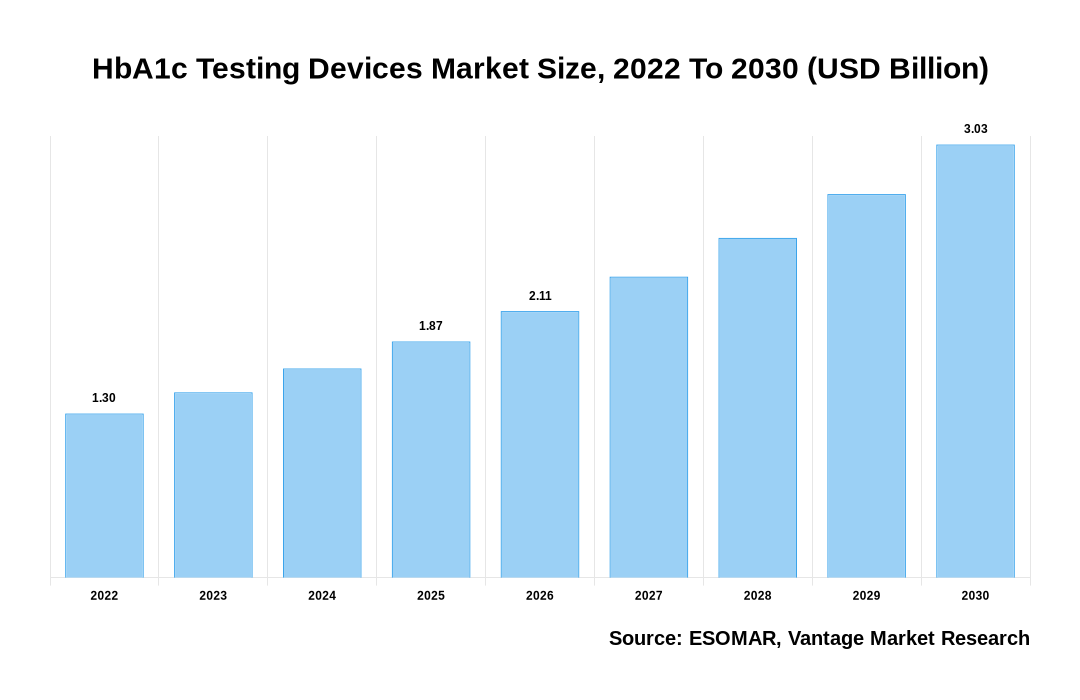Global HbA1c Testing Devices Market
As stated in our extensive report, the Global HbA1c Testing Devices Market accounted for USD 1.3 Billion in 2022 and is projected to reach a value of USD 3.03 Billion by 2030.
The global HbA1c Testing Devices market refers to the need for devices used to measure glycated hemoglobin (HbA1c) levels in the blood. HbA1c is a form of hemoglobin used to measure the average blood sugar levels over time, typically 2-3 months. Several types of HbA1c Testing Devices s is available in the market, including laboratory-based devices, point-of-care devices, and portable devices. Laboratory-based devices are typically used in hospitals and diagnostic laboratories, while point-of-care devices are used in clinics and doctor’s offices for immediate results. Mobile devices are smaller and designed for home use, allowing patients to monitor their HbA1c levels regularly.
The global HbA1c Testing Devices market is anticipated to grow significantly in the coming years, driven by main factors such as the increasing prevalence of diabetes, raising awareness about diabetes management, and technological advancements in HbA1c Testing Devices s. The rising demand for point-of-care testing and self-monitoring devices is expected to boost market growth.
These are the primary factors that must be considered to propel the growth of the global HbA1c Testing Devices market. However, some potential restraints in the HbA1c Testing Devices industry include regulatory hurdles and compliance issues with healthcare standards, limited access to healthcare facilities in certain regions, high costs of device development and manufacturing, the need for highly trained personnel to operate the devices, and competition from alternative testing methods or technologies.
Click To Get a Free Sample On the Research Study

Key factors influencing HbA1c Testing Devices Market Growth
The growth of the global HbA1c Testing Devices market can be attributable to the following:
- The increasing global prevalence of diabetes fuels the demand for HbA1c Testing Devicess. The International Diabetes Federation estimates that the overall number of patients with diabetes is anticipated to rise to 643 million by the year 2030 and 783 million by 2045, highlighting the need to monitor blood glucose levels using HbA1c Testing Devices s regularly.
- Continuous technological advancements have resulted in the development of more accurate and efficient HbA1c Testing Devices Introducing portable and point-of-care devices enables convenient and quick testing, driving market growth.
- Point-of-care testing is gaining popularity due to its convenience and ability to provide immediate results. HbA1c Testing Devicess is widely used in point-of-care settings such as clinics, hospitals, and home healthcare, contributing to market growth.
- Individuals are growing aware of the importance of regularly monitoring blood glucose levels for effective diabetes management. This awareness has increased demand for HbA1c Testing Devicess, as they provide insights into long-term blood sugar control.
- Governments across the globe are implementing various initiatives to tackle the rising prevalence of diabetes. These initiatives include providing subsidies and reimbursement policies for HbA1c Testing Devicess, further driving market growth.
- The aging population is more susceptible to diabetes and related complications. As the global elderly population grows, the demand for HbA1c Testing Devicess is expected to increase, boosting market growth.
- An increasing number of individuals prefer self-monitoring devices for convenient and regular monitoring of their blood glucose levels. HbA1c Testing Devicess allow individuals to monitor their condition from the comfort of their homes, contributing to market growth.
North America Region to Lead the Market
North America HbA1c Testing Devices market is getting more significant with maximum market share during the forecast period. The area’s dominance can be attributed to factors such as a high prevalence of diabetes and advancements in healthcare infrastructure. The increasing adoption of advanced diabetes management techniques and rising awareness about the importance of glycemic control have driven the demand for HbA1c Testing Devicess in the region. Also, the presence of leading market players and continuous research activities in diabetes management further contribute to the market’s growth. Additionally, lucrative Compensation Programs and government initiatives to combat diabetes provide further impetus to the market in North America. Overall, the North America region is expected to maintain its leading position in the HbA1c Testing Devices market in the foreseeable future.
Conclusion
Increasing prevalence of diabetes, raising awareness about diabetes management, and technological advancements in HbA1c Testing Devicess are positively influencing the overall HbA1c Testing Devices market.
Some of the key players in the Global HbA1c Testing Devices Market include- Abbott Laboratories (U.S.), ARKRAY Inc. (Japan), Bio-Rad Laboratories Inc. (U.S.), Check Diagnostics GMBH (Germany), Polymer Technology Systems Inc. (U.S.), Danaher Corporation (U.S.), Beckman Coulter (U.S.) F. Hoffmann-La Roche Ltd. (Switzerland) and others.
![[Market Research Reports] – Research Google News Blog | VMR.Biz](https://www.vmr.biz/wp-content/uploads/2022/12/logo-removebg-preview.png)











